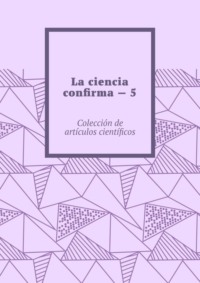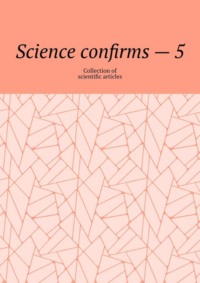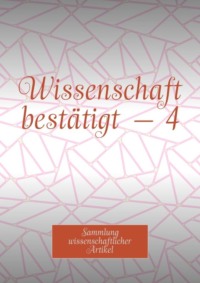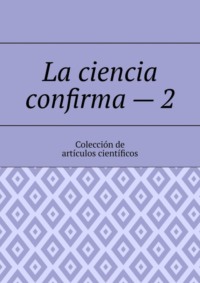
Полная версия
Science confirms – 3. Collection of scientific articles

Science confirms – 3
Collection of scientific articles
Editor Andrey Tikhomirov
ISBN 978-5-0059-5296-7 (т. 3)
ISBN 978-5-0059-4957-8
Created with Ridero smart publishing system
Scientists have found out when a person started using clothes
In a cave on the Atlantic coast of Morocco, archaeologists have discovered more than 60 bone tools that ancient people used to produce clothing made of leather and fur. The age of the finds is 90—120 thousand years. This is the oldest evidence to date of the manufacture of clothing by representatives of Homo sapiens. The results of the study are published in the journal iScience.
The beginning of the use of clothing is an important milestone in the history of mankind. Its appearance not only marks the rise of man to the next step in cultural and cognitive evolution, this innovation has given people the opportunity to settle outside Africa, in colder and more unfavorable regions from the point of view of climate.
Archaeologists and anthropologists agree that Homo sapiens began using clothing in the late Pliocene, but they could not say more precisely until now: leather, furs and other organic materials used for manufacturing are poorly preserved in the archaeological record. Therefore, scientists are constantly trying to find indirect evidence of the appearance of clothing production technologies among ancient people – specialized tools for making skins.
Researchers studying the site of an ancient man in the Contrebandier cave in Morocco have found here about 12 thousand fragments of animal bones, at least 60 of which have been identified by scientists as tools for skinning and skinning. The found bone tools have a certain correct shape, they are polished and smoothed, which indicates long-term use.
Next to the bone tools, the bones of small fur – bearing animals – sand foxes, golden jackals and wild cats – were found with traces indicating that the animals were butchered to skin them. The bones of other animal species found in the cave, belonging to cattle, have marks of a different type, indicating that they were processed for meat.
«The combination of predator bones with traces of skinning and bone tools, which were probably also used for fur processing, provides very convincing indirect evidence of the production of the earliest clothing in the archaeological record,» the words of the first author of the article Emily Hallett from the German Max Planck Institute for the History of Mankind are quoted in the press release of the publishing house. «But given the level of specialization, these tools are probably part of an earlier tradition, examples of which have not yet been found.»
Experts compared the tools from the Contrebandier cave with descriptions of skin treatment tools from other studies and found that they have the same shape and the same markings. The age of the oldest of the finds is 120 thousand years. This is the earliest evidence to date of the emergence of a culture of clothing production and specialized tools for its manufacture.
In general, according to the researchers, the findings from the Contrabandier cave emphasize the emergence of a complex culture in the late Pleistocene in Africa, including the use of a wide variety of materials for the manufacture of specialized tools.
«Bone tools from the Contrebandier cave demonstrate that approximately 120 thousand years ago Homo sapiens began to actively use bones to make specialized tools for solving specific tasks, including processing leather and fur. This feature, apparently, is the basic one for our species, and did not appear after the expansion into Eurasia,» Hallett summarizes.
Learn more: https://ria.ru/20210916/odezhda-1750382673.html
Scientific comments are given in parentheses.
The Bible (Genesis): mention of clothing
Chapter 2:25 And both Adam and his wife were naked, and they were not ashamed. (Shame in the development of human self-identification appears later. Loincloths – from the point of view of religious figures, the loss of innocence led to a sense of shame, and people began to cover the genitals with loincloths (girdles), Christians covered the genitals in sculptures and paintings with fig leaves (hence to show figs – to ridicule Christian mock modesty). Man is the only animal that deliberately covers his body with foreign materials for reasons that we call «modesty», using the «belt of modesty». Other animals can cover themselves with dirt in order to cool the body, or they can use an unoccupied shell as a shelter, but, as far as we can judge, only people have modesty. A. Asimov believed that at first some kind of coverings were needed in order to protect the most sensitive places – for example, the genitals – from contact with the external environment. (When a person stood on his hind legs, the genitals were more open than before.). As people migrated to cooler areas, clothes became heavier and tighter around the body: a person needed artificial heat. The motive of modesty (or, in some cases, shamelessness: after all, sometimes garments were used to emphasize erotic places) appeared, apparently, as a side effect of this utilitarian need for clothing. On the other hand, there are still primitive cultures for which nudity is not considered shameful; there are also developed peoples with similar views – for example, the Japanese; finally, one can recall nudist (from the Latin nudo – to expose, to do naked, to discover, to be discovered) colonies and beaches. The loincloth was used by people to prevent feces from falling or urine from spilling during hunting and in general, since an enemy or a predatory animal could track down the traces of human excrement. By blood (using spears with notches that cause an abundance of blood), traces, droppings, ancient people and current hunters, as well as animals by smell, track down prey. Loincloths were also used to support the genitals, as corsets and bras were later used to support women’s breasts.)
Chapter 3:21 And the Lord God made leather garments for Adam and his wife and clothed them. (Once again proves that the Lord God is a man, or rather tailors who skin animals and use animal skins for clothing. that is, cattle breeding is developing.)
Chapter 9:20 Noah began to cultivate the land and planted a vineyard; (Noah’s occupation with agriculture and, in particular, viticulture).
21 And he drank the wine, and became drunk, and lay naked in his tent. (Description of Noah’s drunkenness, clothes by that time were not only the subject of hiding from the cold, but also became the subject of modesty).
22 And Ham, the father of Canaan, saw his father’s nakedness, and went out and told his two brothers. (Here it is proved that by that time clothes had become a subject of modesty, it became necessary to hide their nakedness with the help of clothes).
23 Now Shem and Japheth took a garment and put it on their shoulders, went backwards and covered their father’s nakedness; their faces were turned back, and they did not see their father’s nakedness. (Once again it is proved that it was impossible for children to see their parents’ nakedness).
24 Noah overslept from his wine and found out what his youngest son had done to him (Noah’s actions towards his youngest son, but in ancient times the rule of the minor was applied to younger sons, that is, all property was given to him).
25 And he said, Cursed is Canaan; he will be a servant of servants to his brothers. (However, it is not Ham who is cursed, but his son, that is, Noah’s grandson Canaan! Canaan is the ancestor of the Canaanites and the writers of the Bible, who covered these events in later times, had to justify the enslavement of Canaan by the Israelites).
26 Then he said: Blessed be the LORD God of Shem; Canaan will be his servant; (Shem had his own God, most likely the god of the tribe of Shem, then there was polytheism, Canaan was proclaimed a slave to Shem. Here again the Israelites’ conquest of Canaan is justified).
Chapter 20:16 And Sarah said, Behold, I have given your brother a thousand pieces of silver; behold, this is a veil for your eyes before all who are with you, and before all you are justified. (A veil to hide the eyes. Headscarves for women – all peoples at different times have a closure of the face, body. For example, the burqa is from the Arab. farajiya – upper loose clothing, veil – from Sanskrit. pata is a fabric, a light female head covering, now a wedding headdress. The face in ancient times was considered the abode of the soul, where the most important features of a woman were, so they were hidden even more carefully than the rest of the body. Nowadays, a resident of Saudi Arabia, having lived with her husband for 30 years, filed for divorce after a curious spouse looked at her face for the first time, removing the veil, thus he violated the law of his wife’s hometown, which prohibits showing her face even to her spouse).
Chapter 24:53 And the servant took out silver things, and gold things, and garments, and gave them to Rebekah; and he also gave rich gifts to her brother and her mother. (Endowment).
Chapter 27:15 And Rebekah took the rich clothes of her eldest son Esau, which she had in her house, and clothed her youngest son Jacob; (Camouflage). 16 and she covered his hands and his smooth neck with the skin of the goats; (Camouflage). 27 He came up and kissed him. And [Isaac] smelled the smell of his clothes and blessed him and said, «Behold, the smell of my son is like the smell of the field that the Lord has blessed; (Deception). 28 May God give you of the dew of heaven and of the fat of the earth, and plenty of bread and wine; (A blessing by deceit!).
Chapter 28:20 And Jacob made a vow, saying, If God will be with me and keep me in this way that I am going, and will give me bread to eat and clothes to put on, (A vow is a contract with a priest).
Chapter 35:2 And Jacob said to his house and to all who were with him, Cast away the strange gods that are with you, and be cleansed, and change your clothes; (There must be one god who will «guide»).
Chapter 37:3 Israel loved Joseph more than all his sons, because he was the son of his old age, and made him a colorful garment. (Joseph is the youngest son, that is, he fits under the right of a minor. Multicolored clothes meant wealth, a kind of being chosen for ancient times, something like the fashion of that time. Expulsion of children – in the animal world, it is often possible to observe the expulsion of their older cubs by females with newborns, this is done by them in order to save the life of a newborn cub and feed it, also a female feeding a newborn does not seek to mate, she does not produce menstruation, this is also observed in humans (often eaten or buried by animals placenta, so that predators do not come to the smell and eat the cubs, according to the ancient African custom of some peoples, including the pharaohs of ancient Egypt, their placenta was buried together with the deceased in a canopic jar). In ancient Russia, group marriage was a form of family life in which a woman and a man from the same family formed a monogamous family for a while. They lived as husband and wife for exactly as long as it took to have children and raise them up to about the age of three. From that moment on, the mother paid less attention to the child, since he was considered old enough to do a variety of work. A woman could have already given birth to a second child, so she either extended the relationship with her former spouse, or moved on to another man. The elder must arrange his own life. Such a phenomenon exists in humans – in Russian fairy tales, older brothers are always treacherous, and the younger one is «good», in Germany, the custom was preserved for a long time when older children left home and arranged their own lives. This is the right of the minor, the ancient system of inheritance of property by the youngest in the family, was replaced by the right of the major – the right of inheritance by the eldest of the heirs, was aimed at preserving and consolidating large landed property). 23 When Joseph came to his brothers, they took off Joseph’s clothes, the multicolored clothes that he was wearing (the clothes were apparently expensive).
24 And they took him and threw him into the pit; but the pit was empty; there was no water in it. (Revenge of the brothers).
25 And they sat down to eat bread, and looked, and saw, behold, a caravan of Ishmaelites was coming from Gilead, and their camels were carrying styrax, balm, and frankincense: they were going to take it to Egypt. (A trading caravan. In religious manipulations, aromatic effects are widely used – the establishment of influence with the help of odors and smoking (myrrh, myrrh, frankincense, etc.). It has been scientifically proven that frankincense contains incensol acetate and is a remedy for depression and acts as an antidepressant. Balms – from the Greek – aromatic resin, natural substances, which include essential oils and resins dissolved in them, aromatic and other compounds. Styrax (in Greek, in Hebrew – nataf – a tree or shrub, the brown-red resin of this tree was used in medicine and cosmetics, the ancient Israelites used this resin when smoking in tents).
26 Judah said to his brothers, «What good is it if we kill our brother and hide his blood?» (Judas is against the murder of his brother).
27 Let us go and sell him to the Ishmaelites, but let not our hands be on him, for he is our brother, our flesh. His brothers obeyed him (It is better to sell Joseph).
28 And when the merchants of Midian were passing by, they pulled Joseph out of the ditch and sold Joseph to the Ishmaelites for twenty pieces of silver; and they took Joseph to Egypt. (Joseph was sold to Egypt. A piece of silver is a Jewish coin).
29 But Reuben came again to the ditch; and behold, Joseph was not in the ditch. And he tore his clothes, (Tearing clothes is an ancient custom of inflicting certain injuries to himself).
30 And he returned to his brothers, and said, There is no lad, but I, where am I going? (Reuben empathizes with Joseph).
31 And they took Joseph’s clothes, and slaughtered the goat, and stained the clothes with blood. (Staging).
32 And they sent a garment of many colors, and brought it to their father, and said, We have found it; see if this is your son’s garment or not. (Father’s deception).
33 He recognized her and said, «This is my son’s garment; a beast of prey has eaten him; surely Joseph has been torn to pieces.» (Jacob believed the deception).
34 And Jacob tore his clothes, and put sackcloth on his loins, and mourned for his son many days. (Sackcloth or sackcloth – sackcloth, clothing made of coarse fabric).
35 And all his sons and all his daughters gathered together to comfort him; but he would not be comforted, and said, With sorrow I will go down to my son in hell. So his father mourned him. (Mourning originates in antiquity. Mourning – according to the rule of talion, grief, mourning clothes, veil, female crying (mourners) – all these are ways to cause pity for the mourner, ways to cause sadness, grief, remorse. A person in grief beats his chest, tears his hair, refuses to eat, thereby trying to punish himself and avoid the upcoming eternal punishment or weaken the punishment he is waiting for for the death of a loved one).
Chapter 38:14 And she took off the garment of her widowhood, and covered herself with a veil, and shut herself up, and sat at the gate of Enaim, which is on the road to Tamnah. For she saw that Shelah had grown up, and she was not given to him as a wife. (Special clothes existed in ancient times for mourning, different countries have different mourning colors in Europe – black, in China – white).
15 When Judas saw her, he took her for a harlot, because she had covered her face. (The woman’s closed face, apparently, meant the opening of the lower part of the body to those who wished).
16 He turned to her and said, «I will come in to you.» For he did not know that this was his daughter-in-law. She said: what will you give me if you come in to me? (Prostitution, one of the oldest professions).
17 He said: I’ll send you a kid from the herd. She said: Will you give me a deposit while you send it? (A pledge is also needed, otherwise it will deceive).
18 He said, «What pledge shall I give you?» She said, «Your seal, and your sash, and your cane, which is in your hand.» And he gave it to her and went in to her; and she conceived by him. (Pregnancy also appeared).
19 And she arose, and went, and took off her veil, and put on the garment of her widowhood. (The widow again).
20 Judah sent a kid by his friend the Adollamite to take the pledge from the woman’s hand, but he did not find her. (Payment).
21 And he asked the inhabitants of the place, saying, Where is the harlot who was in Enaim by the wayside? But they said: There was no harlot here. (Clarification).
Chapter 39:12 She grabbed him by his clothes and said, «Lie down with me.» But he left his clothes in her hands, ran and ran out. (The woman is preparing a trick).
13 But when she saw that he had left his clothes in her hands and ran out (to contradict a woman like that!).
14 She called her household and said to them, «Look, he has brought a Jew to us to scold us. He came to me to lie down with me, but I screamed in a loud voice, (A woman is preparing a trick).
15 And when he heard that I raised a cry and cried out, he left his clothes with me, and ran, and ran out. (Insinuations).
16 And she kept his clothes with her until his master came to her house. (The woman is preparing a trick).
17 And she told him the same words, saying, The Hebrew servant whom you brought to us came to me to abuse me. (Insinuations).
18 But when I raised my voice and cried out, he left his clothes with me and ran out. (Insinuations).
19 When his master heard the words of his wife, which she said to him, saying: your servant did this to me, then he was inflamed with anger; (The insinuation ended with the victory of the deceiver).
20 Then his master took Joseph and put him in the prison where the king’s prisoners were imprisoned. And he was there in prison. (Joseph is in prison).
Chapter 41:14 And Pharaoh sent and called Joseph. And they hurriedly brought him out of prison. He cut his hair and changed his clothes and came to Pharaoh. (Joseph was summoned to Pharaoh). 42 And Pharaoh took off his ring from his hand, and put it on Joseph’s hand; he clothed him in fine linen, and put a golden chain around his neck.; (Joseph is the most important official of the state, visson is an expensive fabric).
43 He ordered them to take him to the second of their chariots and proclaim before him: Bow down! And he set him over all the land of Egypt. (Joseph is the most important official of the state).
Chapter 44:13 And they tore their clothes, and each one laid a burden on his donkey, and returned to the city. (Tearing clothes meant showing a high degree of despair).
Chapter 45:22 To each of them he gave a change of clothes, and to Benjamin he gave three hundred pieces of silver and five changes of clothes; (Pharaoh’s order).
Chapter 49:11 He binds his colt to the vine and his donkey’s son to the vine of the best grapes; he washes his clothes in wine and his robe in the blood of grapes; (Predictions are blessings).
Chapter 50:10 And they came to Goren-haathad by the Jordan, and there they wept with a great and very strong weeping; and [Joseph] wept for his father seven days. (In ancient times, it was necessary to show grief for the deceased. Mourning – according to the rule of talion, grief, mourning clothes, veil, female crying (mourners) – all these are ways to cause pity for the mourner, ways to cause sadness, grief, remorse. A person in grief beats his chest, tears his hair, refuses to eat, thereby trying to punish himself and avoid the upcoming eternal punishment or weaken the punishment he is waiting for for the death of a loved one).
Animal skins – initial clothing
The skins of various animals were the first forms of clothing of ancient man. The skins of various animals were cut up and served as a blanket for a person.
For example, bulls are very often found in legends and beliefs of different peoples. The «Word about Igor’s regiment» mentions «Busovo time», Bus in ancient Greek, bos in Latin – «bull, cow», aka Booz, Boos, God – king and commander of the tribal associations of Slavs (Ants), executed by the Goths in the IV century along with 70 other leaders of related tribes. In ancient Western Semitic languages, «aleph» meant «bull», and «bet» – «house» (in Hebrew, «aleph» and «bet», respectively), hence the name of the first Greek letters «alpha» and «beta» (in the Byzantine pronunciation «vita»), the Russian word «alphabet».
In ancient Egypt, there was, along with other animals, the cult of the bull, it was one of the most magnificent and solemn cults that an animal has ever been honored with, the Memphis bull Apis was considered a «servant of the god Ptah» and a symbol of fertility; he lived in a sacred stable right in the main temple, where he was cared for by special priests. After the death of the bull, it was embalmed and buried in compliance with a complex solemn ceremony and with a huge gathering of people. The priests then went to look for his receiver, and here they looked for some birthmarks – «divine» signs, only a black bull was recognized as a «newborn Apis», who had a white spot in the shape of a triangle on his forehead, a scarab—shaped growth under his tongue, a spot resembling an eagle on his spine, a two—color on his tail wool, etc.; these «divine» signs were allegedly about 30. When such a bull was finally found, which was undoubtedly not an easy task, he was solemnly escorted to a cleaned sacred stable, where he lived with a harem of specially selected cows until his death, the last bull lived to the moment when Egypt became a Christian country. The cult of the «golden calf» was borrowed by the Jews from the ancient Egyptians, who worshipped the bull Apis (hecatomb – in ancient Greece, the sacrifice of a hundred bulls to the gods).
The longest 2nd surah of the Quran is called «Cow».
The ancient Egyptian god Osiris was usually identified with the bull Apis from Memphis and with the bull Mnevis from Heliopolis. It is difficult to say whether these bulls, like red-haired oxen, were incarnations of Osiris as the spirit of bread, or whether they were originally independent deities who merged with Osiris later. These two bulls are distinguished from other sacred animals whose cult was local in nature by the fact that their cult was widespread everywhere. Whatever the original relation of Apis to Osiris, we have one fact regarding the former, which cannot be ignored in any way when discussing the custom of killing God. Although the ancient Egyptians worshipped this bull as a real god, with great solemnity and deep reverence, they did not allow Apis to live longer than the period prescribed by the ritual books. At the end of this period, the bull was drowned in a sacred spring. Apis, according to Plutarch, was allowed to live for twenty-five years. However, recent excavations of Apis graves show that this prescription was not always carried out punctually. From the inscriptions on the tombs it appears that during the reign of the twenty-second dynasty, two of the sacred bulls lived for more than twenty-six years.
The Hindus have a cult of the cow, the killing and eating of whose meat they revere for a crime as heinous as premeditated murder. Nevertheless, the brahmins transfer the sins of the people to one or more cows, which are then taken to the place indicated by the brahmin. Sacrificing a bull, the ancient Egyptians called on his head all the troubles that could fall on themselves and on their land, after which they sold the bull’s head to the Greeks or threw it into the river. The ancient Egyptians worshipped bulls in the historical era, it was their custom to kill bulls and eat their meat. A large number of facts lead us, however, to the conclusion that originally the Egyptians, along with cows, considered bulls sacred animals. They not only considered sacred and never sacrificed cows – they sacrificed only such bulls, on the body of which there were certain marks. Before sacrificing the bull, the priest carefully examined it: if the necessary markings were present, the priest branded the animal as a sign that it was suitable for sacrifice. The man who sacrificed an unbranded bull was himself to be put to death. The cult of the black bulls Apis and Mnevis (especially the first one) played an important role in Egyptian religion. The Egyptians carefully buried all bulls who died of natural causes on the outskirts of cities, after which they collected their bones from all parts of Egypt and buried them in one place. All the participants in the sacrifice of the bull at the great mysteries of Isis wept and beat their chests. So, we have the right to conclude that originally bulls, like cows, were revered by the Egyptians as sacred animals and that the slaughtered bull, on whose head all the people’s misfortunes were heaped, was once a divine redeemer.











